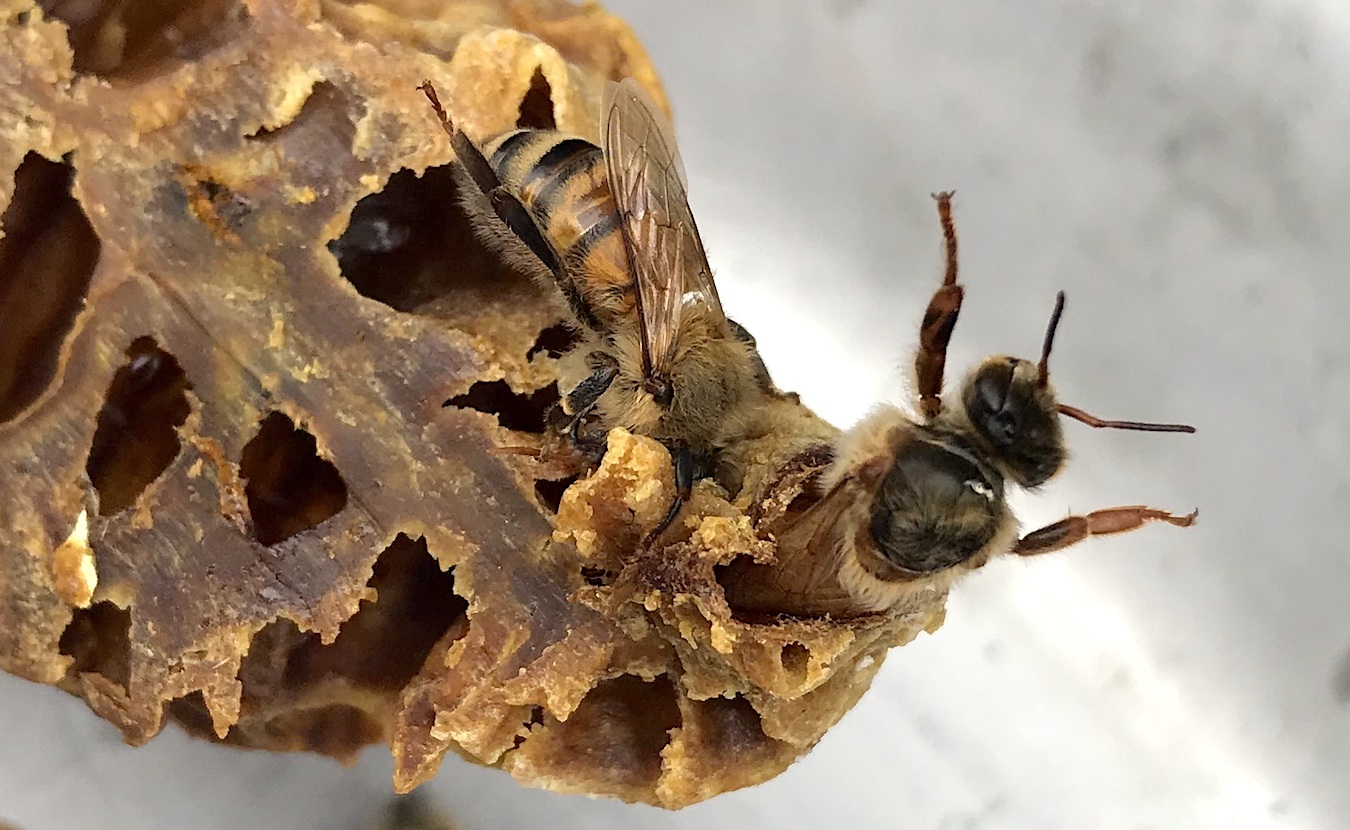Jennifer Bland was considering raising chickens but was discouraged by the prospect of predators on her property. Then, she says, “I was walking through the aisles of Rural King enjoying my popcorn and lamenting over the fact I couldn’t have chickens, and I wandered past an end cap with bee equipment. I paused, thought, ‘Huh. Honey bees.’ Then I called my husband and told him I was going to become a beekeeper!”
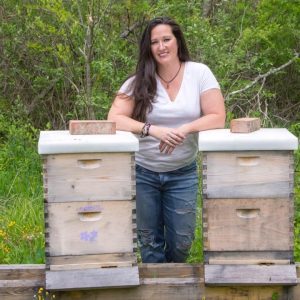
Beekeeping instructor and former sole proprietor of The Virtual Bee, Jennifer Bland, with two of her hives. | Courtesy photo
Ten years later, Jennifer has tended up to nine hives on her twenty acres in northern Monroe County. She also ran a bee products business and helps others become apiarists. She is one of more than 200,000 hobbyist beekeepers in the U.S.
As a beekeeper myself, I heartily agree with Jennifer’s view: “We learn about the environment, the weather, seasons, botany, and ourselves. When you become a beekeeper, you begin to notice the weather changing, you look for signs like sneezing (early tree pollen!) and the first dandelions, because that tells you the bees are starting to increase. You notice when the locust is in bloom and hope it doesn’t rain a lot and wash off the tasty nectar. You notice a honey bee noticing you in the summer and give each other a wink and a nod. In the late summer you notice the first goldenrod bloom and understand the bees are well into their winter prep.”
And beekeeping is like a language passed down through generations. David Branneman grew up helping his grandfather with 100-plus hives in the 1960s.
“He had a roadside honey stand about halfway between Cloverdale and Spencer [in Owen County],” explains Dave, who is a past president of the Bedford Beekeepers Association. “I was carrying empty supers” — aka bee boxes or hive bodies — “from the time I was big enough to do so, was more and more involved helping him and learning from him as I grew older and stronger, and eventually had hives of my own as I learned the business.”
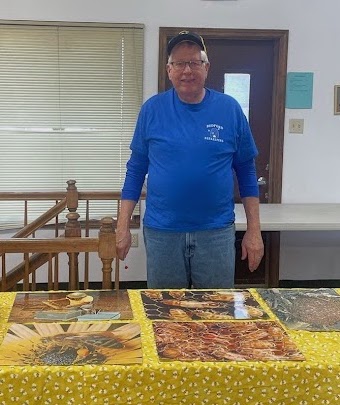
David Branneman, past president of the Bedford Beekeepers Association, grew up in the 1960s helping his grandfather in Owen County with 100-plus hives. | Courtesy photo
Dave’s beekeeping paused during his career in education, but after retiring in 2007 he purchased a couple of hives, which grew to 40. He sold honey locally for several years. He now keeps a few hives at his home just outside of Mitchell in Lawrence County and helps me occasionally with my hives in southern Monroe County.
I started tending honey bees (A. mellifera) as a way to spend time with beekeeping friends and to complement other conservationist activities. I now keep two hives on my two acres near Monroe Lake and the Charles C. Deam Wilderness in Hoosier National Forest. Bees are fun to watch, and they connect me with all the flora and fauna in the three-mile radius where “my girls” forage. Still, it’s discouraging to lose one of my hives, as I do most winters.
When I wrote in Limestone Post five years ago about starting keeping bees (“Plight of the Honeybee — Beekeepers Save Bees for Us All”), I mentioned I wanted to protect my girls from crumpled wing syndrome, from varroa destructors (mites), and from neonics, which remain the most widely applied insecticide in the U.S. Since then, while Europe has banned neonics, the honey bee’s longevity has continued to decline.
What impacts bees’ survival?
“I had four hives last summer,” says Dave, “but I lost a couple last fall. Hive losses tend to run in the 30 percent to 50 percent range.” He advises beginners that if you want one hive, you probably should have two; if you want two hives, you should probably have four, etc. “Losing bees is just a part of modern-day beekeeping,” he says, “and you have to plan to increase every year to keep up with it.”

Erin started tending honey bees as a way to spend time with beekeeping friends and to complement her other conservationist activities. | Photo by Andy Hollinden
Honey bee populations have been declining in the U.S. since the 1940s, going from about 6 million bees to about 2.5 million today, according to the U.S. Department of Agriculture (USDA). The Bee Informed Partnership runs the national Colony Loss and Management Survey. Their most recent survey covered the period between April 2021 and April 2022, when “beekeepers in the United States lost an estimated 39.0 percent of their managed honey bee colonies.” The previous year was worse, with 50.8 percent of hives lost — the highest annual loss on record. And backyard beekeepers — those with fewer than 50 hives, like Jennifer, Dave, and me — experienced a higher annual rate of loss than commercial beekeepers.
Dave says, “Loss of forage and habitat, widespread pesticide and herbicide use, and of course varroa mites are main causes of losses [locally]. Treating for mites is a very necessary part of beekeeping today.” Research is happening, he says, developing mite-resistant bees and more effective mite treatments.
According to Greenpeace, bees are dying from a variety of factors — pesticides, drought, habitat destruction, nutrition deficit, air pollution, climate change, and more. Humans are largely responsible for the two most prominent causes: pesticides and habitat loss. Biologists have found more than 150 different chemical residues in bee pollen. Greenpeace advocates a ban on the seven most dangerous pesticides, preservation of wild habitat, and restoration of ecological agriculture.
“Some researchers speculate that breeders may have accidentally shortened the potential life span while they were improving disease resistance, because shorter lived bees might be less likely to spread disease,” New Scientist reports. The longevity of honey bees has fallen by half over the past 50 years. “When a hive doesn’t have enough worker bees, it’s less likely to survive over the winter,” it says. Shorter lifespans of individual bees mean “less time collecting pollen and nectar, and thus smaller reserves of honey to help the bees survive to the next spring.”
Why are bees important to humans?
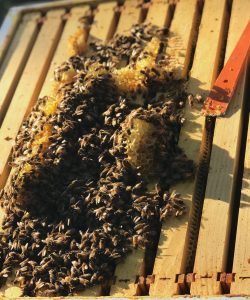
A swarm can contain 5,000 to 20,000 bees, and they are unlikely to sting unless provoked. Scroll down to watch a video and learn more about swarms. | Photo by Erin Hollinden
Chocolate, coffee, and spices are on the line. Bees pollinate one-third of our foods — including apples, melons, cranberries, pumpkins, squash, broccoli, almonds, blueberries, and cherries. The USDA says bees pollinate about 130 types of fruits and vegetables and about 80 percent of the worlds flowering plants.
Honey bees “are among the most lucrative workers in the United States, contributing at least $15 billion to the economy annually,” according to Spectrum News 1 in Texas, where small beekeepers are reporting 2022 was one of their worst years on record for colony loss.
Without bees, millions more people around the world would be malnourished, according to a study by the University of Vermont and Harvard University. “The take-home is: pollinator declines can really matter to human health, with quite scary numbers for vitamin A deficiencies, for example, which can lead to blindness and increase death rates for some diseases,” said University of Vermont scientist Taylor Ricketts, who co-led the study.
“If all of the world’s bees died off, there would be major rippling effects throughout ecosystems,” according to Britannica. Habitats and food webs would be radically impacted, triggering extinctions and declines in various species. “Without bees, the availability and diversity of fresh produce would decline substantially, and human nutrition would likely suffer.”
What’s happening in the bee community in B-town?
Local apiarists are looking forward to the pollen from maple trees, then locust trees and tulip trees. After that, when dandelions and clovers bloom, we start adding honey supers. Luckily, both of my hives appear active as unseasonably warm weather hit us in February. I have not opened them yet to peek in, but my girls are flying in the afternoons.
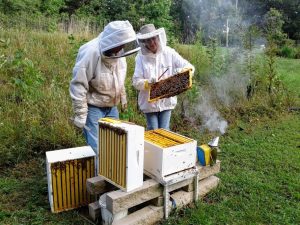
Dave and Erin inspect one of her hives. To the right of the hives is a bee smoker, which is used to calm honey bees. | Photo by Andy Hollinden
Jennifer’s passion for bees led her to start a business called The Virtuous Bee, with a line of organic skincare products featuring honey and beeswax. She ran her business for five years, selling products at several local stores. Now, she finally has her chickens, along with five beehives and other animals. She occasionally teaches beekeeping classes at Ivy Tech Community College.
“Historically,” Jennifer says, “I have had success overwintering and getting through spring since I began only getting bees from swarms or splitting my hives in the late spring, and having a more hands-off approach. I learned bees do what they do despite what I do, not because of what I do! I think nature knows best, and once I relaxed and tried to not be the perfect beekeeper, I became a better one.”
Meanwhile, Dave plans to split his current hives this summer and perhaps catch some swarms in addition. (Scroll down for more on swarms.) And he continues to share his experience with others. He encourages people to plant pollinator-friendly flowers and ground covers. There are seed programs available through the Lawrence County Soil and Water Conservation District to encourage pollinator plantings. Anyone interested in getting plants is encouraged to call them at (812) 279-8117, extension 3.
LOCAL BEE RESOURCES
The mission of Bloomington’s Bee Town Beekeepers Club is to learn and share all bee-related things with the community, spread their love of bees, and educate people about the plight of the honey bee. In the past they have held monthly meetings and mead-tasting events. They are currently mostly a Facebook group, with Jennifer Bland as one of their administrators. New folks and experienced beekeepers are encouraged to find them at Facebook.com/groups/Bloomingtonbeekeepers/.
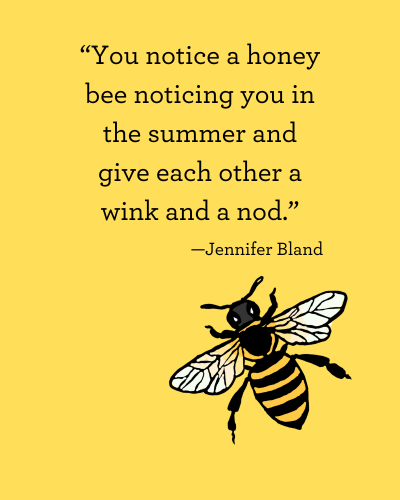 Bedford Beekeepers Association has meetings monthly, every third Tuesday, 7 p.m., at the Central Church of Christ Education Building, at 1401 12th St. in Bedford. They hold larger events, such as beginning beekeeper classes, advanced workshops, and Bee Intensives. “We run a mentoring program for beginners,” says Dave Branneman, past president of the organization. “We participate in the state beekeeper’s association Jump Start Program to get free equipment and bees to a beginner each year and run our own similar program locally for youth to get involved. We also keep some hives in the local community gardens in our area for education purposes and to help pollinate the gardens, as well as do educational programs for a variety of groups from master gardeners to third-graders, nursing homes, county fairs, library presentations, county extension programs, and more.” You can learn more about Bedford Beekeepers Association at their Facebook page.
Bedford Beekeepers Association has meetings monthly, every third Tuesday, 7 p.m., at the Central Church of Christ Education Building, at 1401 12th St. in Bedford. They hold larger events, such as beginning beekeeper classes, advanced workshops, and Bee Intensives. “We run a mentoring program for beginners,” says Dave Branneman, past president of the organization. “We participate in the state beekeeper’s association Jump Start Program to get free equipment and bees to a beginner each year and run our own similar program locally for youth to get involved. We also keep some hives in the local community gardens in our area for education purposes and to help pollinate the gardens, as well as do educational programs for a variety of groups from master gardeners to third-graders, nursing homes, county fairs, library presentations, county extension programs, and more.” You can learn more about Bedford Beekeepers Association at their Facebook page.
The Beekeepers of Indiana (Indianabeekeeper.com) held their annual Bee School in February, in Muncie.
Bloomfield (Greene County), Contact: Ginger Porter, 812-698-0424, porterginger@yahoo.com
Columbus (Bartholomew County), Contact: Robert Littiken, 812-343-7327, robert.littiken@comcast.net
Indiana University has a Beekeeping Club webpage, but no one could be reached for this article.
Lawrence County Soil and Water Conservation District offers seed programs to encourage pollinator plantings. 812-279-8117, extension 3.
Nashville (Brown County), 10 o’clock Beeline, Contact: Mark Partridge, 317-771-2474, indypartridge@aol.com
Spencer (Owen County), Honey Creek Beekeepers, Contact: Earl Schnell, 812-598-9162, earlschnell@yahoo.com
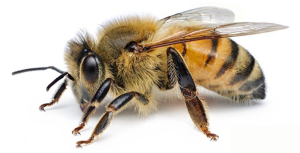
Honey bee | Photo by Thomas Shahan, Oregon Department of Agriculture, CC BY-NC-ND 2.0
Honey bees
Apis mellifera is the genus of most honey bees worldwide, and there are seven to twelve different species. Mine are hybridized from Italian bees, which have mated with various visiting drones over the years — what David Branneman of Lawrence County calls “mutts.” Most species of American-kept bees started out as bees from Germany, Italy (probably mine), or Russia. There are Carniolan honey bees, Buckfast honey bees, and Caucasian or Georgian honey bees. —Erin Hollinden

Bee friendly
Pollinator-friendly flowers and ground covers include columbine, milkweed, butterfly weed, tickseed sunflower, aster, and coneflower, as well as various trees, shrubs, grasses, and sedges. —EH
Tickseed sunflower | Photo by OakleyOriginals, CC by 2.0.

Beekeeper Jennifer Bland introducing a swarm to a hive. | Courtesy photo
A perfect swarm
Beekeepers add to their hives by catching swarms of bees. A swarm happens when a large number of bees, including the queen, “leave their former nest and look for a new home,” according to the University of California Agriculture and Natural Resources. A swarm can contain 5,000 to 20,000 bees, and they are unlikely to sting unless provoked.
“Usually within 100 to 200 yards of the original hive, the bees alight on an object and form a cluster, which looks like a seething, fuzzy glob of insects. Sometimes bees fly from the cluster to collect water and food, but most workers leaving the cluster are scouts that search out potential new home sites for the swarm. When they return from a good site, they dance on the cluster to communicate the location of their find.”
However, many people buy bees raised elsewhere. States with the most domesticated bee populations and sales to other states include North Carolina, California, the Dakotas, Florida, and Texas. But it makes sense that those raised in Indiana would thrive most in Indiana.
Scroll down to watch the video “Catching Swarms,” by the University of Guelph Honey Bee Research Centre.

